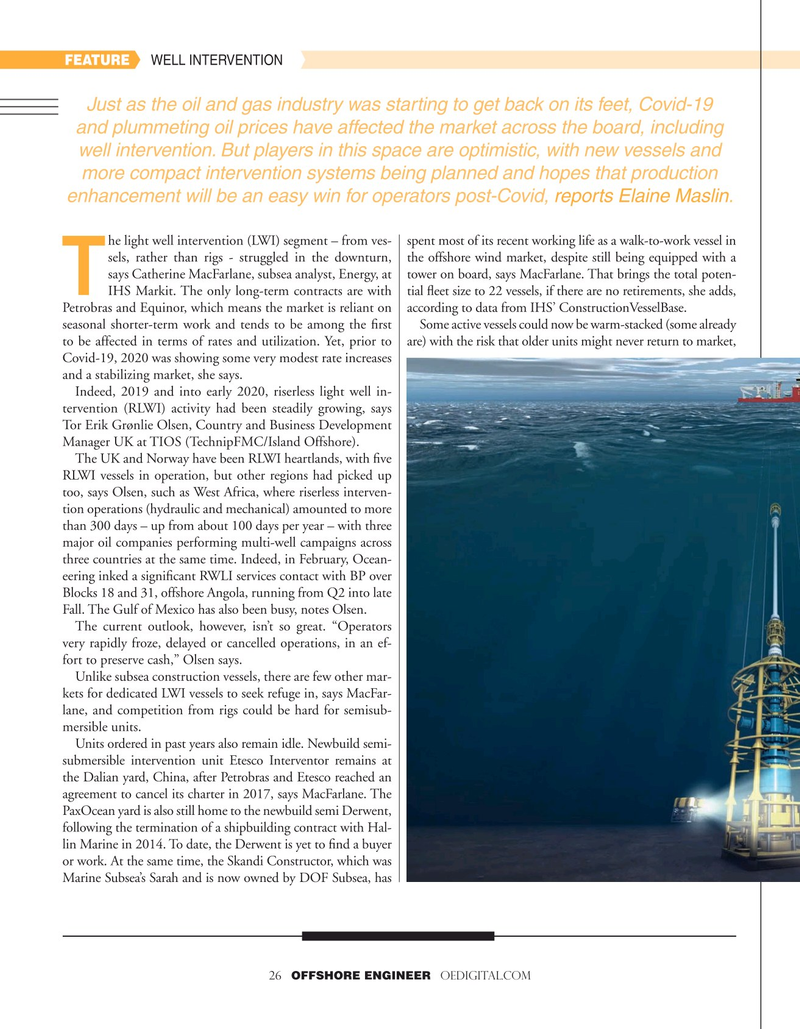
Page 26: of Offshore Engineer Magazine (May/Jun 2020)
Read this page in Pdf, Flash or Html5 edition of May/Jun 2020 Offshore Engineer Magazine
FEATURE WELL INTERVENTION
Just as the oil and gas industry was starting to get back on its feet, Covid-19 and plummeting oil prices have affected the market across the board, including well intervention. But players in this space are optimistic, with new vessels and more compact intervention systems being planned and hopes that production enhancement will be an easy win for operators post-Covid, reports Elaine Maslin. he light well intervention (LWI) segment – from ves- spent most of its recent working life as a walk-to-work vessel in sels, rather than rigs - struggled in the downturn, the offshore wind market, despite still being equipped with a says Catherine MacFarlane, subsea analyst, Energy, at tower on board, says MacFarlane. That brings the total poten-
T
IHS Markit. The only long-term contracts are with tial feet size to 22 vessels, if there are no retirements, she adds,
Petrobras and Equinor, which means the market is reliant on according to data from IHS’ ConstructionVesselBase.
seasonal shorter-term work and tends to be among the frst Some active vessels could now be warm-stacked (some already to be affected in terms of rates and utilization. Yet, prior to are) with the risk that older units might never return to market,
Covid-19, 2020 was showing some very modest rate increases and a stabilizing market, she says.
Indeed, 2019 and into early 2020, riserless light well in- tervention (RLWI) activity had been steadily growing, says
Tor Erik Grønlie Olsen, Country and Business Development
Manager UK at TIOS (TechnipFMC/Island Offshore).
The UK and Norway have been RLWI heartlands, with fve
RLWI vessels in operation, but other regions had picked up too, says Olsen, such as West Africa, where riserless interven- tion operations (hydraulic and mechanical) amounted to more than 300 days – up from about 100 days per year – with three major oil companies performing multi-well campaigns across three countries at the same time. Indeed, in February, Ocean- eering inked a signifcant RWLI services contact with BP over
Blocks 18 and 31, offshore Angola, running from Q2 into late
Fall. The Gulf of Mexico has also been busy, notes Olsen.
The current outlook, however, isn’t so great. “Operators very rapidly froze, delayed or cancelled operations, in an ef- fort to preserve cash,” Olsen says.
Unlike subsea construction vessels, there are few other mar- kets for dedicated LWI vessels to seek refuge in, says MacFar- lane, and competition from rigs could be hard for semisub- mersible units.
Units ordered in past years also remain idle. Newbuild semi- submersible intervention unit Etesco Interventor remains at the Dalian yard, China, after Petrobras and Etesco reached an agreement to cancel its charter in 2017, says MacFarlane. The
PaxOcean yard is also still home to the newbuild semi Derwent, following the termination of a shipbuilding contract with Hal- lin Marine in 2014. To date, the Derwent is yet to fnd a buyer or work. At the same time, the Skandi Constructor, which was
Marine Subsea’s Sarah and is now owned by DOF Subsea, has 26 OFFSHORE ENGINEER OEDIGITAL.COM

 25
25

 27
27